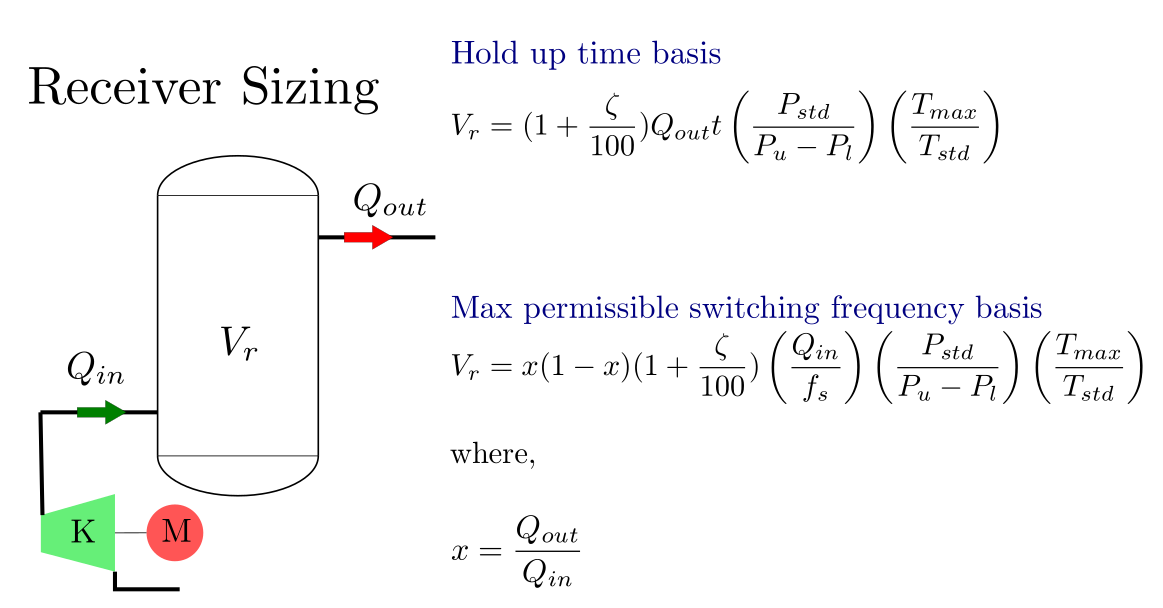Receiver Sizing Calculation¶
Design Formulas¶
Notations¶
The following notations are used in this calculation:
\(P_{std}\) : The reference pressure for standard conditions at which the standard flow rate is declared. This is usually 1.01325 bar. This is considered as a user input to allow custom reference conditions.
\(T_{std}\) : The reference temerature for standard conditions at which the standard flow rate is declared. This is usually 15°C. This is considered as a user input to allow custom reference conditions.
\(t\) : Hold up time period. This is the time duration for which the receiver vessel should be able to cater to the consumer when no input supply is available.
\(t\) : Hold up time period. This is the time duration for which the receiver vessel should be able to cater to the consumer when no input supply is available.
\(f_s\) : Maximum permissible frequency (cycles/hour) of load/unload or start/stop for the associated compressor charging the receiver. More than acceptable cycles may potentially damage the equipment/driver.
\(Q_{in}\) : Incoming flow rate to the vessel, which is usually from a compressor. Hence, the compressor capacity can be used as the input here. T
\(Q_{out}\) : Outgoing flow rate from the vessel to the consumers. When sizing the vessels for maximum permissible switching frequency, the worst case scenario is realised when this flow rate is half the incoming flow rate.
\(P_{u}\) : This is the upper pressure set point, which represents the maximum pressure to which the receiver is charged initially. The chrging compressor must be capable of delivering the specified flow corresponding to this pressure.
\(P_{l}\) : This is the lower pressure set point, which represents the minimum pressure to which the receiver is depleted. The pressure requirement of all consumers must be below this minimum pressure.
\(\zeta\) : A safety factor to be applied on the final receiver size calculated to absorb any uncertainties or future demand growth.
\(T_{max}\) : The maximum temperature at which the gaseous fluid is deemed stored in the vessel. Where this receiver is fed through a cooler, this can be assumed to be coolant plus the approach temperature. As most air/nitrogen compressors may adopt an air cooled discharge cooler, this temperature can be considered as maximum ambient plus approach (~ 10°C).
\(V\) : Receiver volume as calculated to satisfy the design criteria.
\(V_{rec}\) : Recommended receiver volume considering worst case load factor. This is applicable for sizing based on permitted cycles when the air compressor capacity is known with certainity but the demand flow rate is considered uncertain.
Receiver Size for Hold Up time¶
Considering that general receiver application is at low to medium pressures, ideal gas equation is considered sufficiently accurate for our purpose and will lead to conservative estimates for storage volume. The ideal gas equation is :
For a demand flow rate of \(Q_{out}\) for a duration of time \(t\). The total volume of gas consumed from the receiver at standard condition is \(V_{c}\) can be given as:
Equating the no of moles consumed from the receiver (\(n_{c}\)) as the difference of no of moles of gas present initially (\(n_{i}\)) and finally (\(n_{f}\)) in the receiver we have the following mole balance equation:
Making use of the ideal gas equation, we can write the above mole balance equation as:
Or after rearrangement,
Upon substituting the value of \(V_c\) from equation (2), we get:
the final useful formula for the size of the receiver as
Introducing the design margin (\(\zeta\)) as known we get the final form as the formula:
Important
Receiver Sizing Formula for a given hold up time
Receiver Size for Switching Frequency¶
From the equation as derived above for the reservoir volume based on hold up time, we can also derive an expression for the time taken to charge or discharge a vessel between \(P_u\) and \(P_l\), by a simple rearrangement of the same equation. The time \(t\) can be expressed as:
where,
If the maximum permissible frequency of load/unload (\(f_s\)) is known. The total time period of the charge discharge cycle (\(t_{cycle}\)) can be expressed as:
the overall cycle can be broken down in two parts i.e. charge and discharge. During charging phase the net flow is \(Q_{in}-Q_{out}\) and during the discharge phase the net flow is \(Q_{out}\).
Upon substitution we have:
Using the definition of the load factor we have:
Upon substituion in the above and rearrangement we get:
rearranging
substituting back the value of K we get the following:
If the design margin specified is \(\zeta\), introducing it in the above equations gives us the formula for the receiver volume based on permissible switching frequency:
Important
Recevier Volume based on permissible switching frequency
The function \(x(1-x)\) has a maxima at \(x=0.5\), and its value is \(0.5(1-0.5)=0.25\). So, if the outflow is uncertain (which is always a right assumption in this context), the recommended receiver volume is obtained as:
Important
Recevier Volume based on permissible switching frequency for worst case load factor of 0.5
